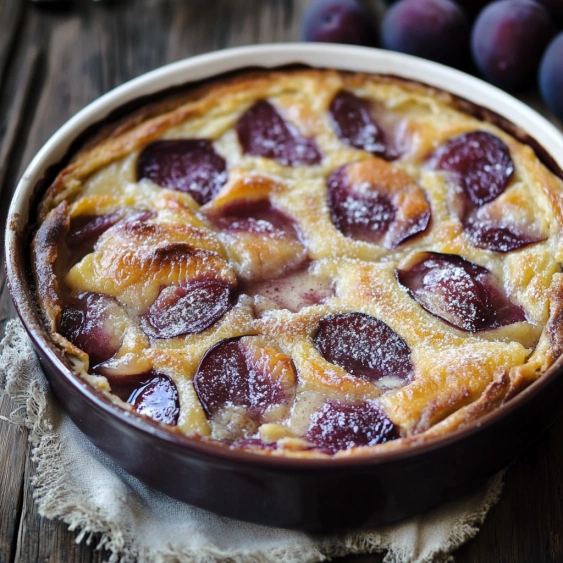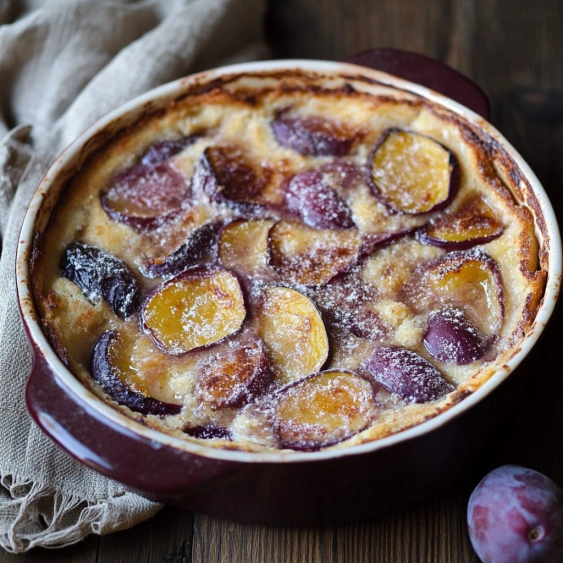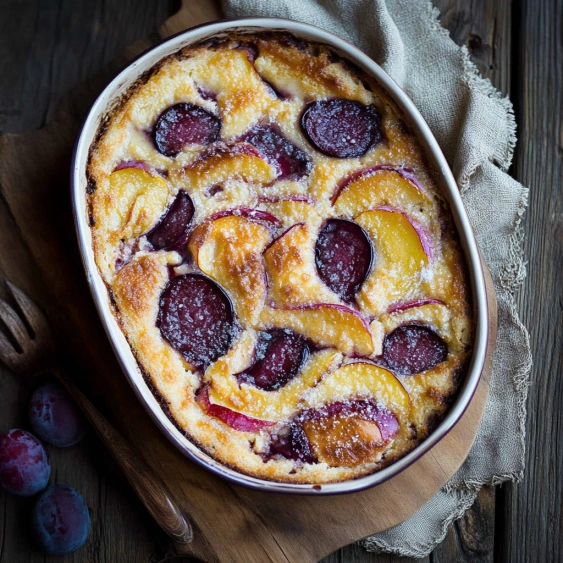 Pin it
Pin it
This rustic French plum flaugnarde celebrates the perfect harmony between juicy summer plums and a delicate custard. The simplicity of this dessert belies its sophisticated flavor profile, making it ideal for both casual family dinners and elegant entertaining occasions.
I first discovered flaugnarde while traveling through rural France, where a local grandmother served it still warm from the oven. The contrast between the tart plums and creamy custard won me over instantly, and I've been perfecting my version ever since.
Ingredients
- Fresh plums: Perfectly balances the sweetness of the custard with their natural tartness
- Eggs: Provide structure and richness to the custard base
- All purpose flour: Creates the perfect texture without becoming too cake-like
- Sugar: Enhances the natural sweetness of the fruit without overwhelming it
- Heavy cream: Adds luxurious richness essential for authentic flavor
- Whole milk: Creates the proper consistency for the silky custard
- Kirsch or other liqueur: Introduces complexity and depth of flavor
- Vanilla extract: Rounds out the flavor profile with warm aromatic notes
Step-by-Step Instructions
- Prepare the baking dish:
- Generously butter a 6 to 8 cup baking dish, preferably one that's deeper rather than wider. This shape creates the perfect ratio of fruit to custard in each serving. The butter prevents sticking and contributes to a delicious golden exterior.
- Arrange the plums:
- Carefully place the pitted and sliced plums across the bottom of your buttered dish. Distribute them evenly to ensure every serving has a good balance of fruit and custard. The juice from the plums will infuse into the custard as it bakes.
- Mix the custard base:
- Begin by whisking together eggs, flour, sugar, cream, salt and about a third of the milk until completely smooth. This gradual incorporation prevents lumps from forming. Then add the remaining milk, kirsch and vanilla, whisking until the mixture is silky and uniform.
- Bake to perfection:
- Pour the custard mixture gently over the plums and bake at 400°F for approximately 20 minutes. Look for a slight wobble in the center rather than complete firmness. The custard will continue setting as it cools. The high temperature creates a beautiful golden top while maintaining a creamy interior.
- Add the finishing touch:
- After removing from the oven, wait just a minute before sprinkling with a teaspoon of sugar. This creates a subtle, sweet crust that contrasts beautifully with the tender custard beneath.
 Pin it
Pin it
The kirsch liqueur is my secret weapon in this recipe. While optional, it elevates the flavor profile dramatically by enhancing the natural fruitiness of the plums. My grandmother always said that a splash of spirits makes any fruit dessert sing, and after years of experimentation, I completely agree.
Seasonal Variations
The beauty of flaugnarde lies in its adaptability to whatever fruits are in season. Summer brings opportunities for cherries, peaches, or apricots as stunning alternatives. In fall, try sliced apples or pears with a touch of cinnamon. Winter versions work beautifully with frozen berries or poached fruits. The custard base remains unchanged while the fruit creates entirely new dessert experiences throughout the year.
Serving Suggestions
Flaugnarde shines when served slightly warm, about 20 minutes after emerging from the oven. A light dusting of powdered sugar creates an elegant presentation, though purists may prefer it unadorned. For true decadence, add a small scoop of vanilla ice cream or a dollop of lightly sweetened whipped cream. In France, this dessert often appears alongside afternoon coffee or tea, though it makes an equally lovely finale to dinner.
 Pin it
Pin it
Historical Context
Flaugnarde hails from the Limousin region of France, where it was traditionally made with black cherries. When prepared with cherries specifically, the dessert is called clafoutis, while versions made with other fruits take the name flaugnarde. Country cooks developed this recipe to showcase local fruits in a way that stretched ingredients during leaner times. The custard provides substance and protein, making it more nourishing than many other desserts. Every family has their unique variation, passed down through generations.
Storage Tips
This dessert maintains its quality remarkably well. Keep leftovers covered in the refrigerator for up to three days. Allow to come to room temperature before serving, or gently warm in a low oven. The custard will firm slightly when chilled but returns to its creamy consistency when brought back to temperature. For longer storage, the baked flaugnarde freezes well for up to three months when wrapped tightly in plastic wrap and foil.
Frequently Asked Questions
- → What is the difference between a flaugnarde and a clafoutis?
While very similar in preparation and appearance, the traditional distinction is that clafoutis specifically refers to the dessert made with cherries, while flaugnarde is the term used when other fruits like plums, peaches, or apples are used instead.
- → Can I substitute the kirsch with something non-alcoholic?
Yes, you can replace the kirsch with fruit juice (cherry, plum, or apple juice work well), or simply use an additional 1½ tablespoons of vanilla extract or almond extract for flavor.
- → What type of plums work best for this dessert?
Any variety of ripe, juicy plums works well. Red or black plums offer vibrant color, while yellow or greengage plums provide a nice tartness. The key is using fruit that's ripe but still firm enough to hold its shape when baked.
- → Can I make this dessert ahead of time?
Yes, you can prepare the flaugnarde up to a day ahead. It's best served at room temperature or slightly warm. If refrigerated, allow it to come to room temperature before serving, or gently warm in a low oven for 10 minutes.
- → What should I serve with plum flaugnarde?
This dessert is delicious on its own, but can be elevated with a dollop of lightly whipped cream, a scoop of vanilla ice cream, or a drizzle of crème anglaise. For a more rustic approach, a simple dusting of powdered sugar works beautifully.
- → Can I use frozen plums?
While fresh plums provide the best texture and flavor, frozen plums can be used if thawed completely and well-drained to remove excess moisture that could make the custard too runny.
